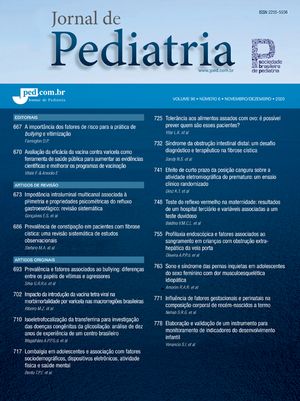
This review encompasses the most recent publications about fungal infection in very low birth weight infants, keeping health professionals updated about this growing problem observed in neonatal units.
Sources of dataOriginal and review articles published over the past 15 years were searched in MEDLINE and Lilacs, using the following keywords: preterm infant, very low birth weight infants, sepsis, fungal infection, antifungal, Candida, amphotericin and fluconazole.
Summary of the findingsInvasive fungal infections affect especially preterm infants. Although new drugs (echinocandins) to treat fungal infection are available, amphotericin is the most widely used drug for the treatment of systemic candidiasis at this stage of life. Currently, there are four types of antifungal agents used in the treatment of fungal infections in neonates: polyene macrolides (amphotericin B deoxycholate and lipid preparations), azoles (triazoles), fluorinated pyrimidines (flucytosine) and echinocandins (caspofungin and micafungin). Two drugs capable of preventing invasive fungal infection are described: nystatin and fluconazole. The pharmacokinetics of fluconazole in the neonatal period is widely known and its prophylactic administration during the first six weeks of life has been associated with less invasive fungal infection in infants weighing less than 1,000 g at birth.
ConclusionsFungal infections constitute an important problem in the neonatal intensive care unit and a better understanding of the incidence, diagnosis, clinical management, treatment, and prophylaxis is important in order to reduce morbidity and mortality. The identification of high-risk preterm infants and the implementation of prophylactic measures and early treatment may improve the outcome of these patients.
Rever as mais recentes publicações sobre infecção fúngica no recém-nascido de muito baixo peso ao nascer, com objetivo de fornecer aos profissionais de saúde atualização sobre um crescente problema nas unidades neonatais. A revisão se dirige especificamente às questões relacionadas a incidência, manuseio clínico, tratamento e profilaxia.
Fontes dos dadosArtigos originais e de revisão, publicados nos últimos 15 anos no MEDLINE e Lilacs, foram identificados usando como palavras-chave: recém-nascido, prematuro, baixo peso ao nascer, infecção fúngica, sepse, cândida, anfotericina e fluconazol.
Síntese dos dadosA incidência de sepse fúngica vem aumentando nas unidades de terapia intensiva neonatal. Embora novas drogas venham se tornando disponíveis (echinocandinas), a anfotericina B continua sendo a droga de escolha para o tratamento inicial. Atualmente, existem quatro classes de drogas disponíveis para o tratamento: os polienos macrolídeos (anfotericina B e formulações lipídicas), os azoles (fluconazol e voriconazol), as pirimidinas fluorinadas (flucitosina) e as echinocandinas (micafungin e caspofungin). Duas drogas vêm sendo descritas na prevenção da doença invasiva: nistatina e fluconazol. Fluconazol é a droga sobre a qual mais se conhece da farmacocinética no período neonatal, e a sua administração profilática em recém-nascidos com menos de 1.000 g por 6 semanas está associada a menor incidência de infecção fúngica.
ConclusõesUm melhor entendimento sobre a incidência da sepse fúngica, diagnóstico, manuseio clínico, tratamento e profilaxia é uma importante arma na morbidade e mortalidade. A identificação de recém-nascidos prematuros de alto risco para o desenvolvimento da doença e a instituição de medidas profiláticas e tratamento precoce podem diminuir a morbimortalidade.








